Juicy and unbelievably tender sous vide chicken breasts. Let’s be real: These are two characteristics that chicken breasts usually lack. In fact, they are often really boring and can be tricky to cook. They usually lack flavor and are almost always dry and chewy, because cooking perfect chicken breasts can be a challenge.
Unlike chicken thighs, which give a nice margin for error, breasts need to be pretty exact for that wow factor. This is when the sous vide technique is superior, and this recipe makes them mind-blowing.
Once you sous vide chicken breasts, you will be hooked. There’s no going back! Seriously! And if steak wasn’t your first sous vide experiment, maybe chicken breast should be. This can be your gateway into the magic of sous vide cooking. And then you totally have to give sous vide fried chicken a try!
What Is Sous Vide Cooking?
Sous what? Sous vide, pronounced “sue veed” is a French term that translates to “under vacuum.” In cooking, it is basically the technique of vacuum-sealing food in a plastic bag and submerging it into a precisely temperature-controlled water bath for a certain amount of time.
That’s all sous vide is. Sounds simple, and it really is! As simple as the concept is, the results are magical.
Sous vide is the secret method that restaurants have been using for years to serve perfectly cooked food. While the chefs are obviously great at cooking, they use sous vide to eliminate guessing and produce textures that are extremely difficult to achieve with traditional methods.
Sous vide can also be combined with other cooking methods; I use it to make amazing results with BBQ smoking, which is a lot of fun.
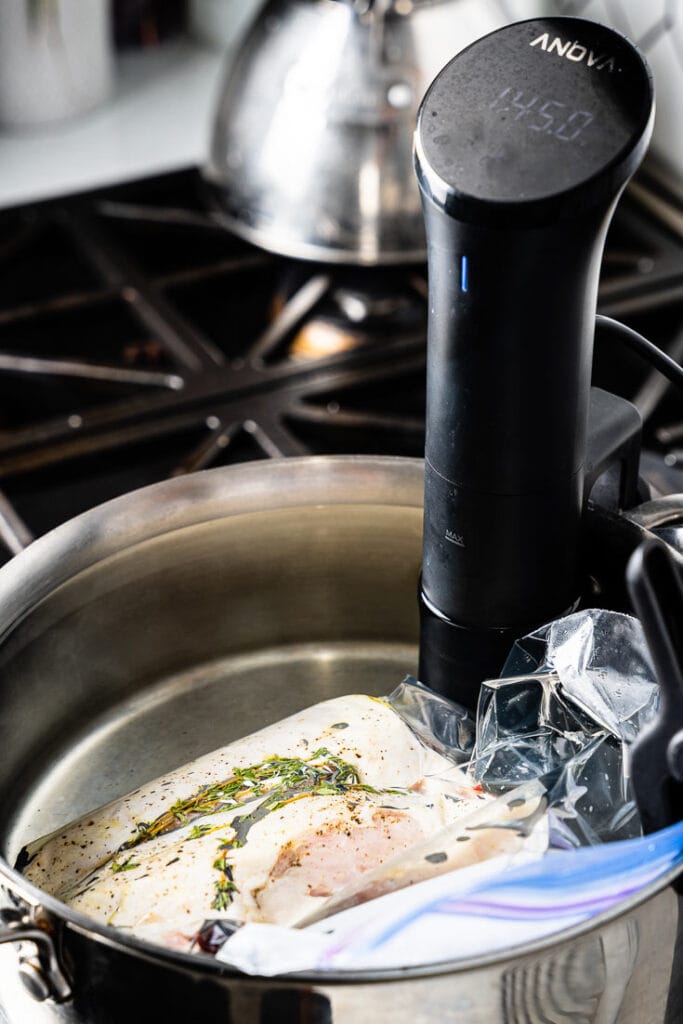
Why Sous Vide Works So Well for Chicken Breasts
When you cook chicken breasts on the stove, grill or in the oven, the chicken needs to reach an internal temperature of 165° F in order to make it safe to eat. The problem with that is the heat source is much hotter than 165°; it’s usually more than double the temperature.
That means that once the chicken is technically “cooked” in the center, the temperature will keep climbing if it isn’t removed from the heat at the perfect time. It also means that the temperature closer to the exterior is going to be hotter than 165° (and yep, that means overcooked). If you want perfectly cooked chicken, your timing has to be perfect, which is really difficult to do.
Sous vide makes it next to impossible to overcook chicken.
This is where the sous vide method has a huge advantage. By cooking the chicken breasts in a lower-temperature water bath for a longer period of time, they get fully cooked and pasteurized. And there’s no possibility of the temperature going higher than what you set it to. This gives a big window of cooking time without having to worry about them overcooking.
When you cook the chicken breasts sous vide, they will cook to the exact perfect temperature with no guessing. Below are the numbers for temperature and time to make it perfect.
145° F for 1 1/2 to 2 hours are the magic numbers.
Here’s why: Cooking boneless skinless chicken breasts always feels like a guessing game. It goes on the grill, when is it done? Do you cut into it to check? Do you use a thermometer? Either way, the chicken breasts just aren’t going to be great.
Boneless Skinless vs. Skin-On Breasts
One of the healthier proteins is chicken breast. It’s often boring and lacks flavor. Not with sous vide. You will be loving the flavor and tenderness even without the crispy skin.
That doesn’t mean that skin-on breasts aren’t amazing. They are my preferred option as the skin adds wonderful texture and flavor when it’s seared at the end.
Advantages of Sous Vide for Chicken Breasts
- Perfectly cooked every time: There’s no guessing; it’s just science and it works.
- The texture is wonderfully tender and juicy.
- Super healthy: You can cook with no added fat.
- Convenient and totally hands-off: Can be prepped or even cooked ahead of time (see below for details).
- Gives you the freedom to entertain dinner party guests while the sous vide does its magic.
- You can add flavors to the bag that will be infused into the chicken while it cooks; though I like to keep it simple with kosher salt, freshly ground pepper and thyme.
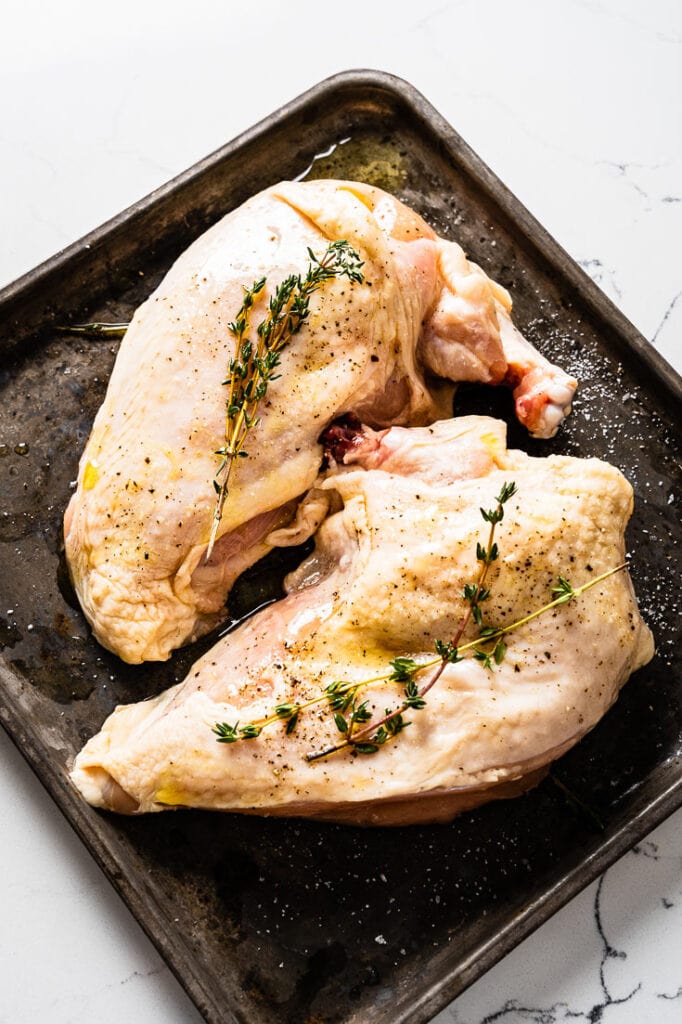
How to Sous Vide Chicken Breasts
If you can cook pasta, you can easily sous vide chicken breasts. Since boneless skinless chicken breasts don’t have a ton of flavor on their own, seasoning and adding fresh thyme or other herbs are pretty key to adding wonderful flavors.
- Fill a large pot or container with water and set the sous vide machine to 145° F / 62.7° C.
- Drizzle a little olive oil on the chicken breasts, then season liberally with Kosher salt and freshly ground pepper and place a few fresh thyme sprigs on each side of the breasts.
- Transfer the chicken to a vacuum seal or Ziplock bag in a single layer so they are as exposed to the water bath as much as possible, along with any sauce or marinade if you are using one.
- Vacuum seal or use the water displacement method (see below for a primer on this), and then carefully submerge into the water bath.
- To keep the bag in place and submerged, clip it to the side of the container.
- Cook the chicken at 145° F for 1 1/2 to 2 hours (the result will be the same within this time window).
- Remove the bag from the water bath and remove the chicken from the bag or chill in the bag if using later or plan to sear.
- Sear the chicken breasts (optional if you have skinless). See below.
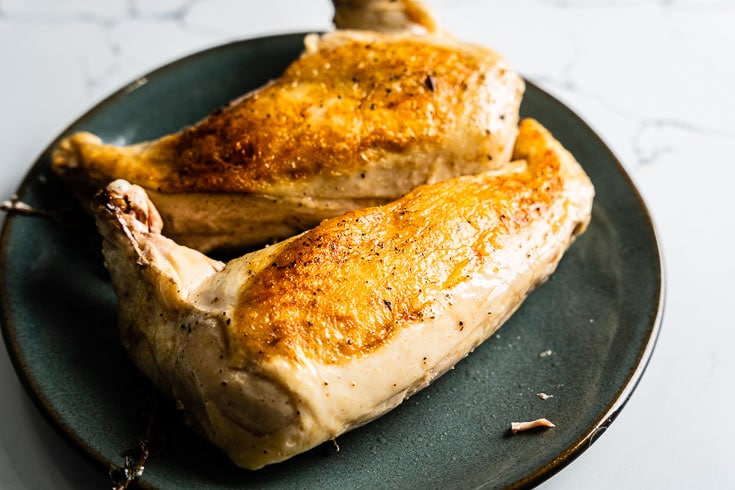
Customize the Texture by Changing the Temp
Sous vide chicken breast temp can vary depending on how you plan to use the finished product. Chicken can be many textures, and customizing your results is as simple as changing the temperature of the water bath.
My go-to for the perfect succulent chicken breast is 145° F / 62.7° C. But if you want to make shredded chicken, you’ll want it to be slightly firmer and a little stringy, so go with 160° F / 71º C.
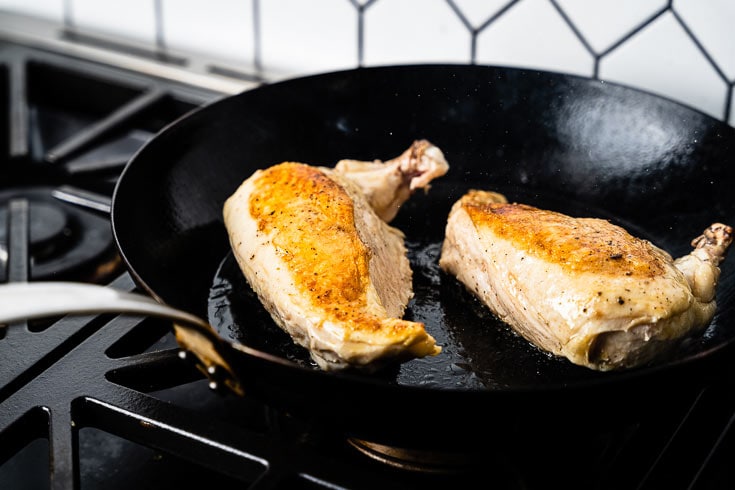
Searing Methods: Options for the Perfect Finish
You definitely don’t want to skip the sear step when using skin-on chicken breasts: After the chicken is cooked in the water bath, you can sear the skin side to give it crispy skin, a definite flavor and a presentation boost.
There’s no need to sear boneless skinless chicken breasts as there is no fat to crisp.
In order to not overcook the chicken, it’s best to cool the chicken down while still in the bag prior to searing. Then dry the skin with paper towels, and season again with a little more kosher salt and pepper (as some of it will have washed off during the cook).
In a skillet (my preferred method): Heat a heavy-bottom skillet over high heat with a little canola oil until it just starts to smoke. Sear the chicken breast skin-side down for 45 seconds to 1 minute to brown and crisp up the skin.
On the grill: If your grill is quick to heat up, a quick sear on the grill can add a lot of flavor.
With a gas torch: Use a gas torch (I recommend the Bernzomatic TS8000) to sear the skin side. Pat the chicken dry and in a safe area away from countertops, very carefully hold the torch 3 to 4 inches from the chicken skin and brown it up. It takes a little practice and patience, but the results can be delicious.
Using Ziplock Bags for Sous Vide (Water Displacement Method)
You can either use a vacuum-seal bag or a Ziplock bag with the same results.
No vacuum sealer? No problem. Just use the water displacement method to remove the air from the bag. To do this, push out most of the air by hand. Close the bag most of the way. Then carefully lower the bag into the water (always leaving the opening above the water line so as not to get any water in the bag). The pressure of the water will push out most of the rest of the air. Seal the bag fully, and it’s ready to go.
It’s important to get as much air out of the bag as possible, so the water can fully be in contact with the chicken for proper cooking. The bag can then be clipped to the side of the container.
It’s also important to keep the food submerged to get it fully cooked. If your bag keeps floating to the surface, place a small bowl or plate on top to keep it submerged.
Meal Prep Tips
The sous vide method is really great for meal planning, and you can do several meals at once. Prep the bags by seasoning the chicken, adding seasonings or a sauce, and vacuum sealing and they are ready to go. You can keep them in the fridge if using in the next few days or freeze them for later use. Just add 60 minutes to the cook time if cooking the frozen chicken breasts.
You can also cook the chicken breast sous vide ahead of time, cool in an ice bath and store in the refrigerator still sealed in the bag for up to 5 days until you are ready to use, or freeze and use a few months later. You can even make some sous vide cheesecake for dessert.
To reheat the chicken: Just place the bag back in a water bath at the same temperature you initially cooked it at for 30 minutes to warm through.
FAQs
The water bath should be set to 145° F / 62.7° C.
The perfect cooking time window is between 1 1/2 and 2 hours but can be left in the water bath for up to 3 hours with almost no difference in texture.
Absolutely! One of the great things about cooking sous vide is you can add vacuum-sealed frozen foods right to the water bath. For boneless skinless chicken breasts, just add an extra hour to the cooking time and everything else is the same.
Yes! Sous vide chicken is safe to eat even though it is not cooked to 165°F. While the FDA recommends cooking the chicken to 165°F to pasteurize it; pasteurization is actually based on both the temperature and time it is at that temperature. The recommended 165°F is really the “nuclear option” to pasteurize it.
Bringing the chicken to 145° F for 9.2 minutes will also pasteurize, reduce the bacteria, without overcooking it. If you cooked chicken 9 minutes after it reached an internal temperature of 165° F in the oven, the chicken would be dry.
If you are interested in learning more, check out this post from Serious Eats on sous vide chicken and food safety.
In the last few years, high-quality consumer-grade sous vide machines have become very popular and inexpensive. The Anova Nano Precision Cooker is a great machine to start with for under $75. A step up in terms of power is the Anova WiFi circulator. Anova also makes some great containers for your water bath.
Check out my post with all the essential Sous Vide Accessories to get you cooking sous vide at your best.
Marinades and Seasonings to Try
One of the great things about cooking chicken breasts sous vide is you can add any flavor you like, and the chicken will totally take on that flavor. I almost always add fresh thyme sprigs to each side of the chicken breast, and each bite has the essence of the thyme flavor.
Try adding lemon slices, BBQ sauce, pesto, chimichurri, other herbs, butter, romanesco, or just about anything else you can think of to add variety and tons of great flavor to your chicken breasts.
Vacuum sealing with a sauce can be impossible unless you have a fancy chamber vacuum sealer. To get around this, you can partially freeze the bag with the sauce and then vacuum seal it. Or just use Ziplock bags and the water displacement method instead.
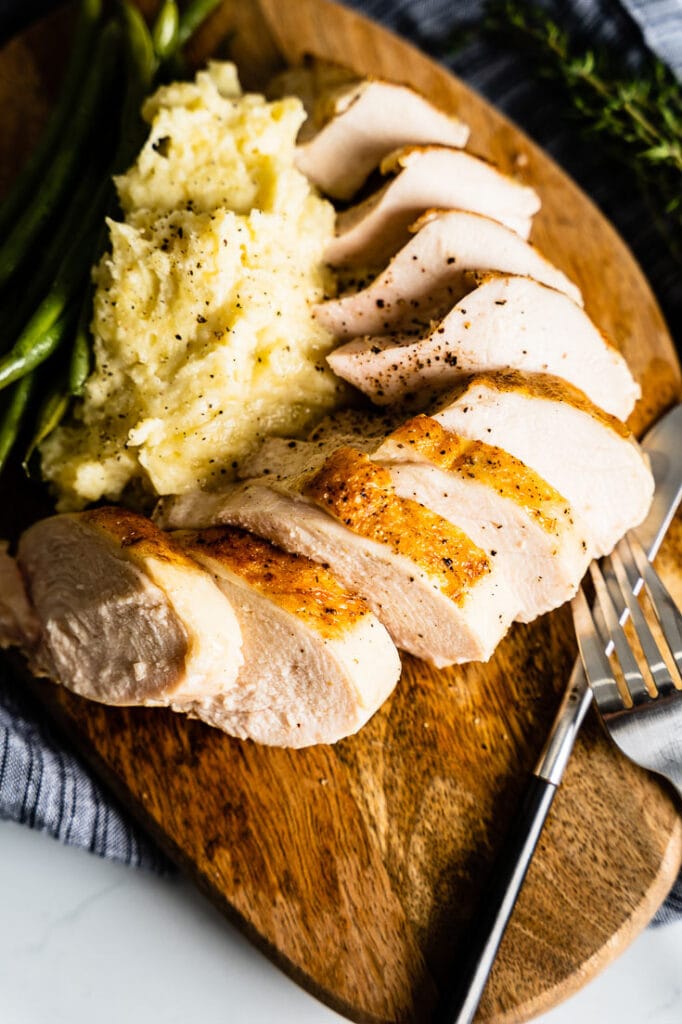
Serving Suggestions
One of the great things about chicken breast is their versatility. In terms of planning menus and cooking ahead of time, sous vide chicken breast is a superstar. The perfectly cooked chicken breasts can be sliced and eaten as is, or on top of a Caesar salad, in a sandwich, pasta, made into a chicken salad, diced and used in tacos and so much more.
For pulled chicken (cook at a higher temp, 160° F / 71º C, as I mentioned above), shred the chicken and toss with a sweet and smoky BBQ sauce.
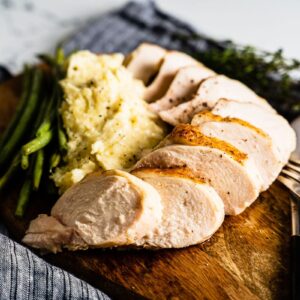
Sous Vide Chicken Breasts
Equipment
Ingredients
- 2 chicken breasts (skin on or skinless)
- olive oil
- Kosher salt
- freshly ground pepper
- 4 thyme sprigs
Instructions
- Fill a large pot or container with warm water and heat the water bath to 145° F / 62.7° C according to your sous vide machine's instructions.
- Drizzle a little olive oil on top of the chicken breasts, then liberally season on both sides with kosher salt and freshly ground pepper. Place a thyme sprig on each side of the breasts, then place the chicken in a vacuum seal bag or Ziplock bag.
- Vacuum seal the bag if using a vacuum sealer; or if using a Ziplock bag, use the water displacement method: Partially seal it, removing as much air as possible, then place it in the water to push the rest of the air out before sealing the rest of the way.
- Clip the bag to the side of the pot or container to keep it submerged, and cook for 1 1/2 to 2 hours (3 if the chicken is frozen).
- Remove from the water bath and rest for 5 to 10 minutes in the bag.
- Remove the chicken from the bag and place on a cutting board to slice or dice.
- To sear skin-on breasts: Heat a heavy-bottom skillet over high heat with a little canola oil until it just starts to smoke. Dry the skin with paper towels, season again with a little more kosher salt and pepper. Sear the chicken breast skin-side down for 45 seconds to 1 minute to brown and crisp up the skin. Serve immediately.
Video
Notes
- This recipe is for two chicken breasts but works the same for more or less quantity. Just keep them flat in the bag.
- If you want to make shredded chicken, cook at 160° F / 71º C; you’ll get a texture that’s slightly firmer and a little stringy.

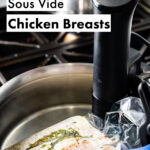
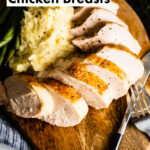
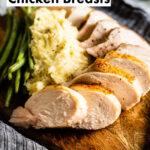
That was the one thing I sad to my tech happy family, we are NOT buying the sous vide operated by an app, “ guys, you don’t know it yet, but we want to be able to cook even if internet is down, or non-existing, like at our summer house.”
I won with that argument, and the Thing works wonders, especially wonderful there. Throw the food in the pot with the thing, paddle for a few hours, and dinner is easy breezy at arrival.
The chicken recipe is so tasty, we are not going back to pots and pans.
Hi Millis,
you are so funny. Totally agree about having a machine that doesn’t require an app. Something so nice about just being able to push a button and it works.
Glad you liked the chicken!
Will try this tomorrow. When you buy a tray of individually-vacuum-packed breast halves, can they be cooked sous vide in those wrappings?
Hi Barbara,
You definitely can cook the chicken in the vacuum-sealed packaging that they come in, but you won’t be able to add any seasonings or flavors to the chicken before cooking, so I don’t recommend it.
App cooking is generally via blue tooth, which is a wireless connection between your phone / laptop and the sous vide machine. It has nothing to do with the internet being up or down. I have a Joule which has a timer, manual temp setting feature as well as pre programmed temps for many different foods. I love it, and its one of the highest rated machines on the market. Just sayin’.
Very tender but too bland and uninteresting on its own for my taste. I want more flavor than a hint of thyme or sage. For 2 breasts, whisk 2 TBSP melted butter, 1 tsp cornstarch and 1 TBSP flour and brush the breasts and sear in 1-2TBSP very hot oil (grapeseed or avocado preferred), approx 1 minute per side. Set aside, covered. Use the juices from the Sous Vide bag and additional low sodium chicken broth as needed, and add to the pan in a recipe for a good pan sauce. I like lemon caper recipe and cranberry bourbon recipe from Cooks Illustrated. Serve over your seared, tender chicken. You will love it!
Another option: smoke cooked breasts in a smoker for 20-30 minutes with a small handful of apple, cherry or oak chips at 150. Chop up the breasts and add to a rice or pasta recipe when nearly complete to minimize any further cooking of the chicken. I like fettucine alfredo and mushroom risotto.
Hi Mark,
I definitely agree that it’s not the most flavorful piece of chicken. This is sort of a starting point recipe to get creative with. Love your suggestions. And the smoked chicken breasts in fettuccini alfredo is one of my favorite things in this world!!!
Cheers,
Justin
Also “SaltWorks” sells excellent naturally smoled salt in a variety of flavors including hickory, alderwood, mesquite and more. If any meat is salted with this stuff, you’d swear it’s been smoked on a grill over natural wood.
Inaugurated our Instant Pot Duo Evo Plus with this Recipe.
We love chicken breast, usually BBQ, or roasted, however it’s very to tricky to gauge the doneness.
Followed this recipe, everything came out wonderful.
Next I would like to tackle ither fish or beef, I am expecting the same great results.
Yay! Great story, Fred! Hope you are enjoying sous vide as much as we do.
Yes, getting a sous vide device was the best thing I could do for chicken breast! Until trying sous vide with it, I loathed being served it – forget about making it at home, when there’s all that tasty chicken thigh meat! Finally, I could make chicken breast even I could anticipate eating with joy.
Oh, re the Joule – if you live as I do where cell service is best on the roof of my house, or at the very beginning of my driveway, and where my satellite internet goes down with just about any heavy storm – be aware you cannot operate the silly thing without using the app! Useless to me here. (They do have good cooking information on that app, and anyone using any device can download it and read it without actually having to depend on being able to USE it.)
So glad to hear it!
I need to do a recipe for sous vide chicken thighs. Thighs are the best part of the chicken, in my opinion.
Didn’t know that the Joule can’t be controlled unless it has internet. There’s just something about having manual controls. 🙂
Happy cooking! Cheers.
The Joule operates off bluetooth not the internet. As long as you have installed the app, youre good to go, internet or no internet.
If it’s cooked at 145, is there enough carry over heat to reach 165 for it to be safe to eat? I’m all for not over cooking chicken breast and I’m getting a sous vide stick very soon so I’m just curious as to the cooking method described. Thanks!
Hi Steve! That’s a great question and one that I want to answer in this post. It gets a little bit complicated and technical, so in the meantime I will refer you to some content from a Serious Eats post about food safety and sous vide cooking temperature. Basically, cooking to 165 degrees is the nuclear option to instantly kill all the bacteria. If cooked at a lower temperature for a longer period of time, it will also kill the bacteria.
Thanks,
Justin
This is not just a plain boring Chicken Breast…it is extremely tender and full of flavor with just 5 simple ingredients. What I love best is the chicken can be eaten plain or added to dishes such as Pesto Pasta for my little tot who will devour the meal!